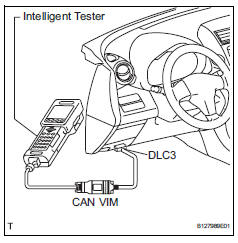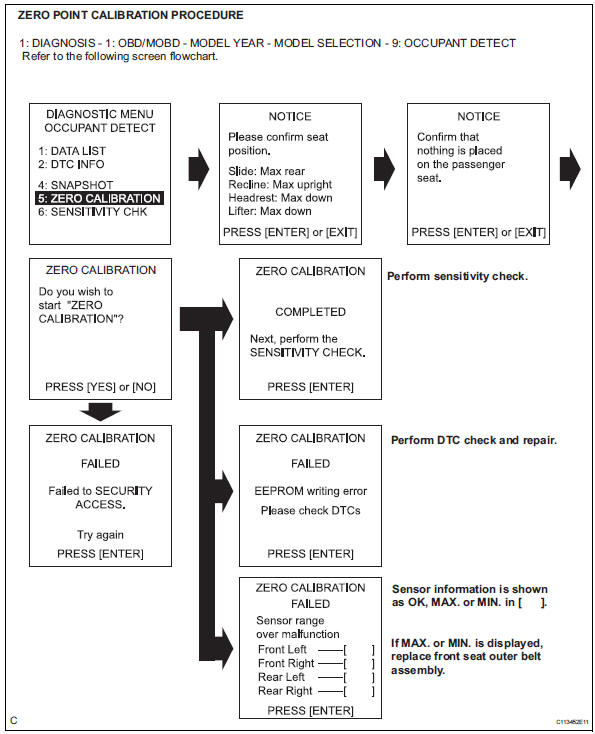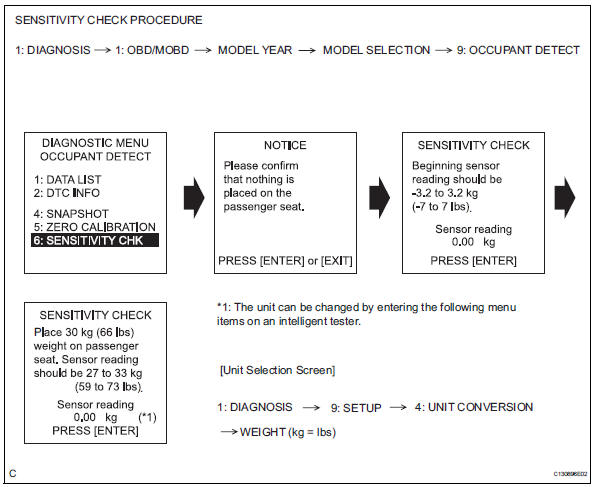Toyota RAV4 (XA40) 2013-2018 Service Manual: Initialization
- Zero point calibration
Notice:
Make sure that the front passenger seat is not occupied before performing the operation.
Hint:
Perform the zero point calibration and sensitivity check if any of the following conditions apply.
- The occupant classification ecu is replaced.
- Accessories (seat cover etc.) Are installed.
- The front passenger seat is removed from the vehicle.
- The passenger airbag on/off indicator (off) comes on when the front passenger seat is not occupied.
- The vehicle is brought to the workshop for repair due to an accident or a collision.
- Zero point calibration and sensitivity check procedures:
Hint:
Make sure that the zero point calibration has finished normally, and then perform the sensitivity check.
- Adjust the seat position in accordance with the
table below.


- Connect the intelligent tester (with can vim) to the dlc3.
- Turn the ignition switch on.
- Perform the zero point calibration by following the prompts on the tester screen.

Hint:
Refer to the intelligent tester operator's manual for further details.
Ok: completed is displayed.
- Perform the sensitivity check by following the prompts on the tester screen.
- Confirm that the beginning sensor reading is within the standard range.
Standard range: -3.2 To 3.2 Kg (-7 to 7 lb)
- Place a 30 kg (66.14 Lb) weight (e.G. A lead mass) onto the front passenger seat.
- Confirm that the sensitivity is within the standard range.

Standard range: 27 to 33 kg (59.52 To 72.75 Lb)
Hint:
- When performing the sensitivity check, use a solid metal weight (the check result may not be accurate if a liquid weight is used).
- If the sensitivity deviates from the standard range, retighten the bolts of the front passenger seat taking care not to deform the seat rail. After performing this procedure, if the sensitivity is not within the standard range, replace the front seat assembly rh.
- If the zero point calibration has not finished normally, replace the front seat assembly rh.
 How to proceed with troubleshooting
How to proceed with troubleshooting
Hint:
Use the following procedures to troubleshoot the occupant
classification system.
*: Use the intelligent tester.
Vehicle brought to workshop
Passenger airbag on/off indicato ...
 Problem symptoms table
Problem symptoms table
Hint:
Use the table below to help determine the cause of the
problem symptom. The potential causes of the symptoms
are listed in order of probability in the "suspected area"
column ...
Other materials:
Purpose of readiness tests
The on-board diagnostic (obd ii) system is designed to
monitor the performance of emission related components,
and indicate any detected abnormalities with dtc
(diagnostic trouble codes). Since various components
need to be monitored during different driving conditions,
the obd ii syste ...
Main body ecu communication stop mode
Description
Wiring diagram
Inspection procedure
Notice:
Turn the ignition switch off before measuring the resistances of the
main wire and the branch
wire.
After the ignition switch is turned off, check that the key reminder
warning system and light
reminder warning syste ...
For safe driving
For safe driving, adjust the
seat and mirror to an appropriate
position before driving.
Correct driving posture
Adjust the angle of the seatback
so that you are sitting
straight up and so that you do
not have to lean forward to
steer.
Adjust the seat so that you
can depress the pedals full ...
